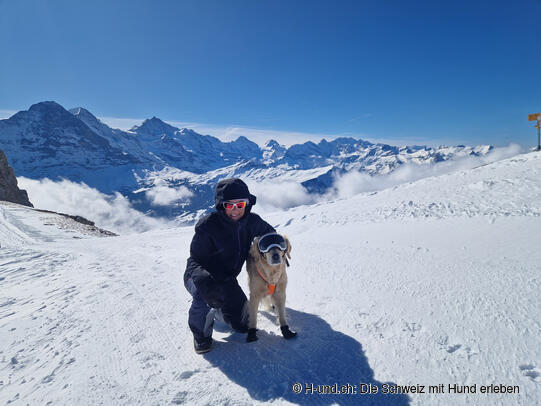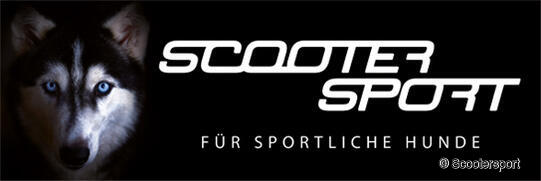Dog glasses - yes or no?
Sensible protection for sensitive eyes

Beitrag sponsored by scootersport.ch
Ski and high mountain tours are in full swing. Especially on high mountain tours in winter, dogs are at increased risk of eye damage due to the harsh conditions and intense sunlight. The decision as to whether dog goggles make sense depends on various factors, especially on tours in the mountains, where snow and reflected sunlight play a major role.
Why dog goggles can be useful
Dog eyes are sensitive to various environmental influences. Special safety goggles can offer advantages in the following situations:
- Protection from UV radiation: In the mountains, the sun's rays are particularly intense, especially when snow reflects the light. Dogs with sensitive eyes or a tendency to eye problems benefit from dog goggles as they protect against harmful UV radiation. Dogs can also suffer from snow blindness - not just humans!
- Protection from wind and cold: Strong winds and icy temperatures can irritate a dog's eyes. Goggles offer protection from the wind and prevent the eyes from drying out or watering - particularly important for sensitive dogs or four-legged friends who love long walks.
- Protection from dust, dirt and foreign objects: On some hikes, especially in dry mountain valleys, dust or small stones can get into the eyes. Dog goggles help to keep such foreign bodies out and protect the eyes from irritation.
- Protection from injuries: Branches, undergrowth or stones thrown up can lead to injuries, especially with active dogs. The goggles are also used for tracking, mantrailing, hunting or when dogs are working in dangerous areas.
- Medical necessity: Dogs with eye problems (e.g. cherry eye) or after eye surgery may require goggles to aid the healing process and prevent further damage.
The right glasses for your dog
Anyone opting for dog goggles should pay attention to the following aspects:
- Perfect fit: The dog goggles must be perfectly adapted to the size and shape of the dog's head. They must be neither too big nor too small to avoid uncomfortable pressure or constriction. Advice from a professional(Scootersport) can help you choose the best fit.
- UV protection: High-quality models offer tested UV protection to provide optimum eye protection.
- High-quality material: Shatterproof and scratch-resistant lenses ensure durability and prevent injuries from splinters.
How to get your dog used to being carried
Even though dog glasses have many advantages, their acceptance is not a matter of course - not every dog wears them voluntarily. With these tips, you can get your four-legged friend used to them step by step:
- Keep calm: Start training when your dog is relaxed.
- Encourage curiosity: Let him sniff the glasses first so that he becomes familiar with them.
- Positive reinforcement: Reward him with praise and treats when he touches the glasses or shows interest.
- Slow familiarization: Start with very short wearing times - a few seconds at first, then gradually longer.
- Stay patient: Don't put your dog under pressure. A sensitive but consistent approach is crucial.
If your dog has difficulty getting used to the goggles, an experienced dog trainer or a partner such as Scootersport.ch can help.





